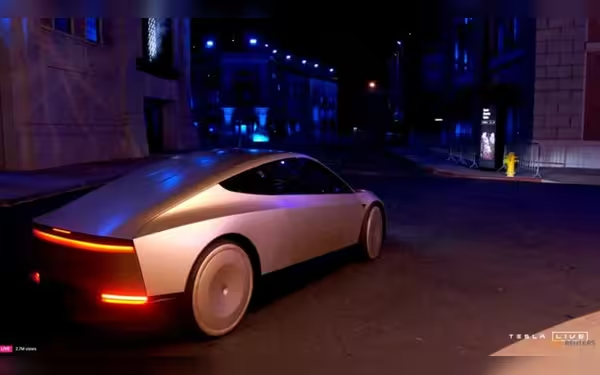Saturday, November 16, 2024 07:32 PM
Tesla Unveils Ambitious Robotaxi Plans Amid Investor Concerns
- Musk promises driverless Cybercab by 2026.
- Investors seek clarity on Tesla's autonomous transition.
- Stock price drops nearly 9% post-event.
 Image Credits: channelnewsasia
Image Credits: channelnewsasiaElon Musk unveils Tesla's robotaxi plans, but investors demand more details amid stock price drop.
Elon Musk, the CEO of Tesla, recently held a much-anticipated event in Hollywood to unveil the company’s plans for driverless robotaxis. This event was filled with excitement and promises, but many investors were left wanting more concrete details about how these ambitious plans would actually come to fruition. During a 20-minute presentation, Musk showcased a sleek, silver two-door "Cybercab" prototype and made bold claims about the future of Tesla's vehicles.
Musk announced that Tesla's popular Model 3 and Model Y cars would be able to drive themselves without any human supervision in California and Texas by next year. He also mentioned that the company plans to start building the fully autonomous Cybercab by 2026, with a price tag of less than $30,000. Additionally, he introduced a robovan that could carry up to 20 people, claiming it would transform urban spaces by "turning parking lots into parks." The event also featured dancing humanoid robots that could mix drinks, which Musk said would be sold for between $20,000 and $30,000 each.
Despite the flashy presentation, many Tesla investors and experts expressed disappointment over the lack of specific details regarding the company’s transition from a traditional automaker to a leader in autonomous driving and artificial intelligence. The stock price fell nearly 9 percent following the event, reflecting investor concerns. Since reaching a record high in late 2021, Tesla's stock has faced challenges, including competition from cheaper electric vehicle (EV) rivals.
Ross Gerber, a Tesla shareholder, voiced his concerns, stating, "His vision is lovely, but somebody has to actualize it." He emphasized the need for Tesla to focus on selling EVs in the immediate future rather than solely on futuristic products like the Cybercab. Investors had previously been excited about the prospect of a lower-priced vehicle, expected to start at around $25,000, but reports indicated that Tesla had abandoned this project.
As Tesla aims to outpace established self-driving competitors like Waymo, it is pursuing a less expensive technological approach. However, experts warn that this strategy has significant weaknesses. Matthew Wansley, a law professor, pointed out that Tesla's software is lagging behind that of its rivals, making it difficult to determine the causes of accidents or failures. This could raise concerns among regulators.
Ramesh Poola, an investment officer, expressed his admiration for the presentation but noted the need for more clarity on how Tesla plans to monetize its new AI and robotics technologies. He also highlighted potential regulatory hurdles that could impact Musk's timeline for unsupervised autonomous driving.
While the excitement surrounding the Cybercab and robovan is palpable, experts believe that widespread adoption of these autonomous vehicles may still be several years away. Tasha Keeney, an investment analyst, remains hopeful that if Tesla can successfully implement its full self-driving system in Texas and California next year, a robotaxi service could follow soon after.
While Elon Musk's vision for Tesla's future is ambitious and filled with potential, the path to achieving these goals is fraught with challenges. Investors and consumers alike will be watching closely to see how Tesla navigates these hurdles and whether it can deliver on its promises. The journey towards fully autonomous vehicles is not just about technology; it also involves addressing regulatory concerns and ensuring safety for all users. As the world moves towards a more automated future, the success of Tesla's robotaxi initiative could significantly shape the landscape of transportation.













